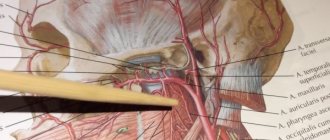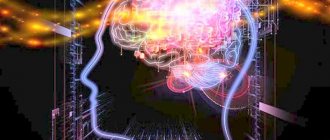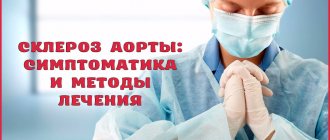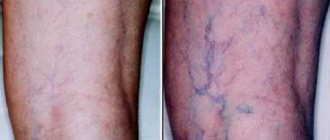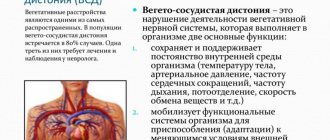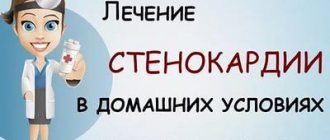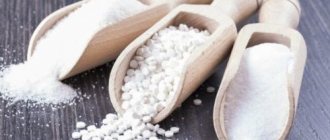The formation of atherosclerotic plaques in the carotid arteries leads to circulatory disorders in the brain. There are no manifestations in the initial stage, then dyscirculatory encephalopathy, transient attacks or acute ischemia (stroke) occurs. Ultrasound, MRI, and CT are used for detection. Surgery is used to remove it; medications and herbal remedies can slow down the progression of vascular disorders (if the course is asymptomatic).
Causes of plaque formation in the carotid artery
The most common causes of changes in the arteries during atherosclerosis are:
- age-related decrease in arterial elasticity;
- hereditary predisposition;
- smoking;
- increased blood pressure;
- unhealthy diet with a predominance of fatty, fried, salty and spicy foods, overeating, lack of fresh vegetables and fruits, unsaturated vegetable fats, fish;
How is an atherosclerotic plaque formed?
- obesity;
- physical inactivity;
- menopause;
- metabolic syndrome;
- diabetes;
- intoxication;
- addiction to alcoholic drinks;
- chronic infections;
- frequent stress overexertion.
We recommend reading the article about atherosclerosis of the neck vessels. From it you will learn about the symptoms and causes of the development of pathology, diagnostics and treatment methods, and preventive measures. And here is more about atherosclerotic plaques.
Why do plaques appear?
It should be recognized that the etiology of atherosclerosis is still not fully understood. Despite this, the reasons that provoke the rapid growth of cholesterol plaques have been identified. Among them:
- Overweight, obesity.
All these factors provoke the accumulation of fat deposits and, as a result, vasoconstriction.
The walls of blood vessels are normally elastic and smooth. As a result of changes at the molecular level, microcracks and protrusions appear in the internal cavity. As a result of an increased amount of bad cholesterol in the blood, gradual sedimentation of fat deposits occurs.
Risk factors for the development of atherosclerotic plaques of the carotid arteries include:
- bad habits;
- sedentary lifestyle;
- excess body weight;
- hypertension;
- prolonged exposure to a stressful situation;
- diseases of the endocrine system;
- poor nutrition.
Some people are predisposed to developing this disease. People at risk include:
- elderly;
- those suffering from hypertension;
- people with diabetes;
- having a genetic predisposition to the appearance of atherosclerosis.
Development mechanism
The main factor in plaque formation is impaired fat metabolism. Metabolic failure leads to impregnation of the inner layer of the carotid arteries with low-density lipid complexes. First, a cholesterol spot appears, then it gradually thickens, connective tissue fibers grow into it, and calcium salts are deposited.
As the plaque grows, it blocks the flow of blood, and when parts tear off from it, emboli form. They move through the blood vessels of the brain, causing them to become blocked.
Cholesterol stain formation
Chronic tissue malnutrition gradually disrupts the functions of brain cells, which manifests itself in the form of dyscirculatory encephalopathy. Its symptoms depend on the size of the plaque, the rate of growth and the ability of bypass blood flow, which decrease significantly with age.
Acute ischemia occurs with thrombosis. If a blood clot or part of a plaque does not tightly block an artery, and there are collateral vessels, then transient (transient) cerebral circulatory failure develops. Complete blockage provokes an ischemic stroke.
Medications
To evaluate the effectiveness of treatment, ultrasound scanning of the neck vessels, in particular the carotid artery, is used. Improved blood flow in them indicates the correct treatment tactics.
Statins are considered the most effective and safe in our time. The mechanism of action of drugs in this group consists of several points. Firstly, they inhibit an enzyme that is key in the synthesis of cholesterol. Secondly, they increase the number of low-density lipoprotein receptors in the liver. This enhances LDL uptake and elimination. Thirdly, they inhibit the absorption of exogenous cholesterol from food.
The most studied representatives of statins are atorvastatin and rosuvastatin. The dose of the drug is selected individually, treatment is carried out over a long period of time under the monitoring of liver function indicators and lipid balance.
In addition to the main one, statins have a number of pleiotropic effects:
- decreased activity of the inflammatory process in atherosclerotic deposits; reduction in plaque size; antioxidant activity; anti-ischemic effect; elimination of endothelial dysfunction; stimulation of the growth of new vessels in areas of cardiac ischemia; positive effect on myocardial hypertrophy; impact on the blood coagulation system.
Drugs in this group are used to treat patients with high triglyceride levels. With their help, you can treat patients with excess weight and metabolic syndrome. Since fibrates reduce uric acid levels, they are indicated to combat atherosclerosis in patients with gout, a pathology in which deposits of uric acid crystals form due to increased levels in the blood. They are mainly observed on the legs, hands, and ears.
The mechanism of action of the drugs is the activation of lipoprotein lipase, an enzyme that is involved in fat metabolism. Like statins, fibrates reduce the activity of the inflammatory process and stabilize atherosclerotic deposits on the inner wall of the artery. The drugs improve carbohydrate metabolism, so they can be used in patients with diabetes.
Ion exchange resins
The second name for drugs in this group is bile acid sequestrants. These include cholestyramine and colestipol. They bind bile acids in the intestines. In response to this, the liver intensively captures lipids from the blood, synthesizing from them the substance that is missing. Thus, the drugs help get rid of the increased amount of LDL in the blood.
Other drugs
These drugs include probucol, ezetemibe, and omega-3 fatty acids. The first remedy increases the concentration of a protein that transports cholesterol to liver cells for subsequent elimination. Ezetimibe inhibits the absorption of fats in the intestine. The mechanism of action of omega-3 fatty acids is not precisely known, but they can reduce lipid levels, reduce the activity of the inflammatory process, and normalize endothelial permeability. All drugs from this group are used only as adjuvant therapy.
Symptoms of atherosclerosis
After a long asymptomatic period, the clinical manifestations of cerebral ischemia usually progress steadily. The first symptoms occur when the patency of the carotid artery decreases by more than half.
In the initial stage, signs of asthenia can be detected:
- increased fatigue;
- dizziness;
- constant weakness;
- irritability;
- apathy;
- daytime sleepiness;
- difficulty falling asleep at night, frequent awakenings.
As ischemic changes in the brain increase, patients experience difficulty:
- concentration;
- intellectual activity;
- quick decision making;
- remembering and reproducing information;
- analyzing events and drawing up plans.
Cholesterol plaque in the vessels of the head (cerebral microstroke)
Progressive cerebral atherosclerosis manifests itself:
- dull headaches;
- a feeling of heaviness or noise in the head;
- mood swings;
- depressive reactions;
- unsteadiness when walking;
- anxiety, tearfulness;
- decreased clarity of word pronunciation;
- trembling of the limbs and head;
- visual and hearing impairment.
The consequence of severe damage to the carotid arteries is dementia. It means an acquired form of dementia, in which there is a significant decrease in memory, speech impairment, ability to maintain personal hygiene, self-care, and orientation in time and space.
Such patients require constant help from outsiders.
Symptoms of the disease
The insidiousness of this pathology is that for a long time it is completely asymptomatic. You can see a cholesterol plaque only with the help of instrumental diagnostics.
Most often, the patient learns about the presence of a cholesterol plaque during a preventive examination, or during the diagnosis of a concomitant disease.
The initial symptom of the disease is dizziness. But most patients do not pay close attention to them, attributing them to workload and increased fatigue.
Over time, dizziness becomes more frequent and longer lasting, and additional symptoms appear:
- Frequent headaches;
- Chronic fatigue;
- Dizziness with nausea;
- Absent-mindedness, decreased concentration;
- Memory impairment;
- Hearing and visual disorders;
- Pre-fainting states and fainting themselves.
At an advanced stage of the disease, the following alarming symptoms may occur:
- Slurred speech;
- Failure of an arm or leg;
- Tingling in one half of the body;
- Loss of vision;
- Fainting;
- Unsteadiness of gait.
If these signs occur, the patient should be taken to the doctor immediately.
Diagnostic methods
When examining the neurological status, one can identify impaired eye movement, asymmetry of the pupils, decreased or increased tendon reflexes, trembling of arms outstretched forward, and the inability to perform tests for coordination of movements.
Instrumental and laboratory examination methods reveal:
- ophthalmoscopy – atherosclerotic retinopathy;
- Ultrasound with duplex scanning and MRI - the presence of a plaque, the degree of disruption of blood flow through the carotid artery;
- EEG – decreased functional activity of the brain;
- biochemical blood test - dyslipidemia, increased cholesterol and triglycerides, glucose (for diabetes), increased tendency to thrombus formation.
Symptoms and treatment of atherosclerosis of the carotid arteries
Atherosclerosis of the carotid arteries is a pathology that means a dangerous disruption of blood flow in the paired main arteries of the neck.
The paired highways of the carotid and brachiocephalic arteries are the main suppliers of blood to the cerebral vessels that supply the brain.
The development of atherosclerosis in the main carotid arteries means the development of atherosclerotic plaques on the wall of blood vessels and obstruction of blood supply due to narrowing of the arterial bed.
The paired highways of the carotid and brachiocephalic arteries are the main suppliers of blood to the cerebral vessels that supply the brain.
Drug treatment
It is impossible to completely get rid of atherosclerosis by any of the known methods. All treatment methods are aimed at preventing the progression of the process and the development of complications.
To do this, first of all, you need to change your lifestyle - eliminate smoking, alcohol, fatty meats, offal, canned food, fast food, confectionery and sweets. The basis of the diet should be fresh and boiled vegetables, fruits, cereals, and fish.
Every day you need to devote at least 30 minutes to physical activity (walking, therapeutic exercises, swimming, dancing, light running). In case of obesity, a necessary condition for the prevention of circulatory disorders in the brain is weight normalization.
Drug therapy includes the following groups of drugs:
- hypolipidemic (Simgal, Lovastatin, Zocor);
- antihypertensives (Enap, Prenesa);
- antiplatelet agents (Tiklid, Cardiomagnyl, Aspirin);
- vasodilators (Agapurin, Cavinton, Nimotop, Sermion);
- nootropics (Phenotropil, Glycine, Somazina);
- stimulants of metabolic processes (Memoplant, Cytochrome, Actovegin).
Treatment methods
Treatment of atherosclerosis should begin in the early stages. It is impossible to completely remove atherosclerotic plaques, but it is possible to reduce their volume and soften the structure. Provided that the patient follows medical recommendations and undergoes all necessary procedures.
General principles
First, you should change your lifestyle - give up bad habits, quit smoking and minimize alcohol consumption. Blockage of blood vessels will not disappear on its own, but to maintain the condition of the blood vessels, it is necessary to engage in physical exercise, spend more time in the fresh air, and reduce body weight.
Without following a diet, the fight against atherosclerotic plaques will be unsuccessful. It is worth giving up foods rich in cholesterol - cocoa, chocolate, animal fats, high-fat milk, offal, eggs. And you should also limit the consumption of baked goods, carbonated drinks, pure sugar and salt.
Set of products allowed for consumption:
- nuts;
- beans, legumes;
- berries;
- cabbage (broccoli, white cabbage, cauliflower, sea cabbage);
- greens - dill, spinach, parsley, celery;
- citrus;
- zucchini and eggplant;
- green tea in unlimited quantities.
These products are rich in Omega 3 acids, iodine and vitamins B, C, A. That is why they are so useful to consume. When the flow of ascorbic acid into the body is established, the vessels restore their tone and are less subject to changes.
Procedures such as general massage, acupuncture, and therapeutic exercises help relieve vascular spasm. You can engage in light sports - swimming, walking, jogging. Against the backdrop of proper nutrition, quitting smoking and alcohol, physical therapy sessions and sports will help significantly improve the patient’s quality of life.
Taking medications
Drug treatment of atherosclerosis is based on taking drugs from the following groups:
- statins - Pravastatin, Atorvastatin, Simvastatin (normalize the amount of cholesterol in the blood, controlling its production by the body itself;
- capillary dilating agents - Pentilline, Pentoxifylline;
- drugs that improve blood circulation - Cilostazol;
- lowering cholesterol levels, in addition to statins - fibrates Ciprofibrate, Clofibrate;
- vitamin complexes – Aevit, Ascorutin, Ascorbic acid;
- derivatives of nicotinic acid.
The dosage, necessary medications, course of administration - all this is determined by the attending physician. Self-medication is dangerous due to the development of side effects and complications, since statins and fibrates can negatively affect liver function if not treated correctly.
Surgical treatment
The operation is indicated in severe cases of atherosclerosis, when the disease threatens the health and life of the patient. Stenting is the operation most often performed for problems with blood vessels. Under the control of an angiograph, a balloon with a stent is inserted into the affected area of the body directly into the artery. With the help of gas, the stenotic vessel expands, then a stent is installed there, which will maintain normal blood circulation and prevent the capillary from narrowing again.
Coronary artery bypass surgery - allows you to resume blood flow impaired by blockage. A bypass path of blood supply is created, avoiding completely blocked vessels. For a shunt, a healthy capillary is taken, for example, from the femoral area. If the plaques have completely blocked the lumens of the arteries in the legs, and the limb is already affected by gangrene, the necrotic part is amputated.
If plaques no longer resolve on their own, even with lifestyle changes and diet, doctors may recommend a type of surgery
Removal via operation
Indications for surgical treatment are:
- repeated attacks of cerebral ischemia;
- stroke;
- narrowing of the lumen of the carotid artery by more than 70%;
- unstable plaque.
In this case, the cholesterol plaque can be removed from part of the inner membrane (endarterectomy of the carotid zone) and a connection can be formed to bypass the site of the obstruction (bypass surgery). In some cases, balloon expansion is prescribed with the installation of a metal frame - a stent, or carotid artery replacement.
Watch the video about the concept of removing cholesterol plaques:
About treatment
The following methods are used in the treatment of atherosclerosis of the carotid arteries:
- A positive effect, especially at the initial stage of development of this disease, can be obtained without using medications. The patient must change his lifestyle; to help, he is prescribed a special diet, attending physical therapy classes, and massage rooms. Sometimes this is enough to cure an incipient disease.
- In order to dilate blood vessels and dissolve cholesterol plaques, medications are prescribed. A diagnostic test will help determine which is best for the patient.
- In cases where it is impossible to get rid of the disease with the help of medications, that is, atherosclerosis in the vessels of the neck, carotid arteries and other arteries of the body has led to changes that threaten life, surgical intervention is prescribed. Various methods are used to treat atherosclerotic changes in the internal carotid arteries (ICA). One of them is thrombolysis, when a special drug is injected into the vessel, with the help of which cholesterol growths are dissolved in the internal artery. In this case, you can get a complication in the form of hemorrhage. During laser treatment, plaque evaporates as a result of the action of the laser. Plaques can be removed using carotid endarterectomy. This method of surgical intervention, when arterial tissue is dissected and cholesterol growths are removed, is the most effective. Recovery time after surgery is minimal. Plaques can be removed using carotid angioplasty and stenting. A small incision is made. Installing a stent at the site of blockage of the vessel helps prevent its further narrowing. When using surgical intervention, you need to know that until the causes leading to this disease are eliminated, the manifestations of signs of the disease will resume after some time.
- It is good to treat the disease using traditional methods. At the same time, you can drink decoctions and infusions of the well-known valerian and motherwort. They have a calming effect and help dilate blood vessels. When using hawthorn, blood flow to the brain and blood pressure are normalized. The use of horse chestnut helps in thinning the blood and normalizes fat metabolism. Infusion of rose hips and sea buckthorn, the use of folk recipes from garlic can have a positive effect on lipid metabolism. But at the same time, it is important that the patient definitely consults a doctor so as not to harm himself. The use of some herbs can cause thrombosis or even stroke. People have long used leeches in the treatment of various diseases. Currently, hirudotherapy has begun to be widely used, including for this disease. But it should be noted that it should be carried out only in medical institutions.
How to remove using traditional methods
Herbal medicine is indicated only for early manifestations of atherosclerosis or to prevent its occurrence in hypertension, diabetes, family history, and old age. For this, herbs are used that prevent the penetration of fats into the inner lining of the arteries, improve the neutralization of cholesterol with bile acids, and help remove excess lipids from the body.
Medicinal teas may include:
- red clover flowers;
- mulberry leaves and fruits;
- hawthorn berries and flowers;
- knotweed grass;
- raspberry leaf;
- chokeberry berries;
- Sudanese rose flowers;
- skullcap Baikal herb;
- astragalus herb;
- rose hips fruits.
To cleanse arterial vessels, a collection of equal parts of immortelle and chamomile flowers, St. John's wort, and birch buds is used. A tablespoon is filled with 400 ml of boiling water and placed in a thermos overnight. The infusion is taken 200 ml in the morning and evening before bed with the addition of a teaspoon of linden honey.
We recommend reading the article about carotid artery stenosis. From it you will learn about risk factors and symptoms of pathology, degrees of stenosis, diagnosis and treatment. And here is more information about stenosing atherosclerosis.
Cholesterol plaque in the carotid arteries reduces blood flow to the brain. This is manifested by discirculatory encephalopathy or transient ischemic attack. When the blockage is complete, an ischemic stroke occurs. In the early stages, atherosclerosis leads to nonspecific symptoms of asthenia; as it progresses, dementia may appear.
For treatment, medications and surgical removal are used; herbs can be used for preventive purposes.
How to remove cholesterol plaques from the carotid artery and cure atherosclerosis
One of the most dangerous pathologies of the vascular system is atherosclerosis, which occurs as a result of blockage of blood vessels. If cholesterol plaques form in the carotid artery, this is atherosclerosis of the carotid arteries. Blockage of these vessels, which pass through areas of the chest, neck, brain and supply blood to the human brain, can lead to severe damage to it and end in a stroke.
The cause of the formation of atherosclerotic plaques is considered to be:
Removal of cholesterol plaques in the carotid artery
Removal of cholesterol plaques on the carotid artery at the second stage (fibrosis) and at the third stage (calcionosis) can occur in several ways:
- increasing blood (arterial) pressure - but this path is fraught with the formation of new damage to blood vessels and, as a consequence, the formation of new atherosclerotic deposits;
- dilatation of blood vessels, however, this method is ineffective on the carotid artery and is used more often for varicose veins of the extremities;
- increased tone of blood vessels;
- cleansing the blood of cholesterol - however, this method does not so much destroy existing plaques as prevent the formation of new ones.
The cost of removing cholesterol plaques on the carotid artery using medications is entirely determined by the cost of the drugs used. The cost of surgical treatment (carotid endarterectomy, angioplasty, stenting) is even higher if it is not done according to the insurance policy. Surgical treatment is resorted to when conservative methods fail.
How to remove cholesterol plaques from the carotid artery safely? Surgery has some risks, and drug treatment has contraindications and side effects. Drug treatment can be aimed at reducing the level of cholesterol synthesis by the liver, increasing energy metabolism in cells - this is how it is possible to remove excess cholesterol from the blood and carotid arteries. An alternative is infusions and herbs for cholesterol plaques, but their effectiveness remains unproven.
How to treat cholesterol plaque on the carotid artery at the second stage? The second stage means the formation of fibrin threads (“bridges” of connective tissue) between individual atherosclerotic deposits - it is not always impossible to treat cholesterol plaques that have undergone fibrosis without surgical intervention (it is possible to stop the condition and achieve partial regression of the plaque by taking cholesterol pills). On the other hand, cholesterol plaques in the carotid artery may not require treatment - they can grow to a certain point, after which they enter the stage of zero activity.
Cleanse the liver
Adherents of alternative methods of treatment believe that cleansing the liver is an effective method that helps improve fat metabolism. This organ breaks down excess cholesterol and also produces its endogenous fraction. Cleansing helps improve its detoxification function. Stagnation of bile in the hepatic ducts also causes functional disorders of the hepatobiliary tract.
The one-day diet is one of the fastest ways to cleanse the liver. To do this, you need to prepare cranberry juice without sugar and clean water (ratio 1:3). There you should add ½ teaspoon of ground cinnamon and ¼ teaspoon of nutmeg powder. Boil the resulting mixture over low heat for about half an hour, cool and pour in the juice from three large lemons. During the day of the diet, you need to drink 2 liters of drinking water and 2 liters of medicinal medicine. You cannot eat food during cleansing! To treat the liver in this way, you need to consult a medical specialist!
Any medical specialist will tell you that it is impossible to completely remove plaques from the vascular bed! To combat fatty blockages of blood vessels, there are traditional and non-traditional methods that slow down the growth process of formations and prevent the appearance of new growths.
Causes and types of arterial atherosclerosis
Atherosclerosis is a chronic disease of blood vessels that occurs due to fatty deposits on their inner surface. All deposits are formed in the form of cholesterol plaques, followed by sclerosis (overgrowth of connective tissues) and calcification.
As a result of such processes, the lumen of the vessel narrows, up to their complete blockage. Similar processes occur on the inner surface of the carotid arteries.
From the above we can conclude that atherosclerosis of the internal carotid arteries is a very dangerous disease. If a blockage of blood vessels occurs, blood will stop flowing to the brain, which can lead to ischemia, death of nerve tissue, stroke and death.
In some cases, it is possible not to block blood vessels, but to tear off a cholesterol plaque, which will follow the bloodstream to the brain. The consequences in this case are similar to the previous ones.
Today there is no single theory that would indicate a clear cause of the disease. On numerous websites you can see reasons such as age, smoking, obesity, high blood pressure, etc. In fact, these are not causes - they are risk factors that can worsen the disease.
Cholesterol plaques in the carotid artery are formed as a result of:
- Violation of lipid metabolism - a large amount of lipoproteins are infiltrated in the vascular walls, which lead to atherosclerosis;
- The peroxide theory emphasizes disruption of antioxidant metabolism;
- The hormonal theory suggests that the cause may also be a large amount of gonadotropic hormones that stimulate cholesterol synthesis;
- Autoimmune reaction - scientists are of the opinion that the reaction of leukocytes and other macrophages to vascular walls can lead to atherosclerosis.
Despite the variety of theories, the most common cause in practice is a disorder of lipid metabolism, which results in an increase in the level of cholesterol in the blood, which negatively affects the condition of the inner walls of the carotid arteries.
Today there is no single theory that would indicate a clear cause of the disease. On numerous websites you can see reasons such as age, smoking, obesity, high blood pressure, etc. In fact, these are not causes - they are risk factors that can worsen the disease.
Indications for surgery
The attending physician makes conclusions based on the identified pathologies:
- serious, more than 70% narrowing of blood vessels, stenosis;
- artery blockage;
- protrusion of the wall (aneurysm).
- detection of irregularities or ulceration of the inner lining of the artery;
- a sharp deterioration in general condition - increased headaches, dizziness, tremors, impaired coordination of movements, memory loss, disturbances in the functioning of the speech apparatus.
If the doctor suggests surgery, do not refuse! Such operations give a good effect at the stage of development of the disease, when deterioration is observed periodically.
There are three main types of carotid artery surgery:
- Expansion of the lumen of the vessel using stenting. A modern method that allows not only to prevent the development of ischemic stroke, but also to significantly reduce the rehabilitation period.
- Excision of the blood clot along with part of the artery (thrombinthymectomy).
- Creation of an artificial channel to bypass the area with the thrombus using anastomosis.
The postoperative period usually does not exceed two weeks. The speed of recovery depends entirely on the patient and his desire to follow the recommendations of the attending physician, which are as follows:
Possible consequences
The most severe consequence of arterial atherosclerosis is stroke.
The development options for this condition can be very different, however, the consequences are sad in all cases:
- decreased blood supply to the brain. At some point, the blood supply stops almost completely, and brain hypoxia occurs;
- blockage of small vessels. If the plaque ruptures, the piece begins to migrate through the vessels. If it gets into a small blood vessel, it will immediately become blocked, leading to the death of this area;
- blood clot formation. If the blood clot is large, then a stroke develops due to impaired blood supply.
- nutrition correction. Meals should be regular, divided - at least 5 times a day. Diet also plays a big role. It is necessary to completely eliminate or at least reduce to a minimum foods rich in cholesterol or consisting mainly of easily digestible carbohydrates: carbonated sweet drinks, smoked foods, sweets, and any semi-finished products. You should also give up coffee (especially instant coffee) and alcoholic beverages;
- stop smoking, as nicotine slows down metabolism and blood flow in the vessels;
- Give your body regular physical activity. Regular physical activity helps strengthen the walls of blood vessels, and also speeds up metabolism and helps accelerate the transfer of oxygen through blood vessels.
Symptoms
Carrying out complex diagnostic measures to determine plaques in the carotid artery (atherosclerosis) is based on medical history and patient complaints. In the early stages of the disease, symptoms may be mild or similar to other pathologies. That is why the patient himself and even the attending physician may not realize that atherosclerosis is developing until the blood supply to the brain is significantly impaired.
The following symptoms are characteristic of oxygen deficiency in brain tissue:
- migraine;
- insomnia;
- decreased performance;
- memory problems;
- speech disorders;
- difficulty concentrating;
- feeling of heaviness in the head, as if you have a cold;
- noise in ears;
- sudden darkening of the eyes;
- increased physical and mental fatigue.
Precursors of a stroke may include sudden weakness or numbness, usually on one side of the body, slurred speech, poor coordination, and sudden blindness in one eye. If any of these symptoms occur, you should consult a doctor immediately. This condition is called a transient ischemic attack and can last from several tens of minutes to a day. The most dangerous consequence of TIA, which occurs as a result of a significant decrease in the lumen of the carotid artery, rupture of an atherosclerotic plaque in the carotid artery and blockade of small vessels or blood flow, can be a stroke. More extensive brain damage has the risk of becoming irreversible.
Normally, the arteries are smooth, elastic and distensible, which ensures normal blood supply to the brain. The blood carries oxygen and other nutrients to the cerebral cortex through the arteries. In the absence of normal blood supply, the human cerebral cortex is very sensitive to lack of oxygen.
How to suspect a problem?
Atherosclerosis of any localization develops very slowly. Often, 15-20 years pass from the moment deposits begin to form until the first symptoms appear. The vessels of the cervical spine and the carotid arteries are responsible for the blood supply to the brain. Atherosclerosis usually affects the latter. Cholesterol plaques that form inside the vessels of the neck obstruct the flow of blood to the brain. It does not receive the required amount of oxygen and nutrients, which leads to a decrease in the performance of the organ.
Cholesterol plaques in the vessels of the neck begin to bother a person only when they reach a large size. In addition to nonspecific symptoms (chronic fatigue, dizziness, memory impairment, decreased activity of thought processes), there are characteristic signs of atherosclerosis of the carotid arteries:
- weakness;
- numbness of the limbs, often only on one side;
- dizziness, loss of coordination;
- foggy thinking;
- unexpected, sharp headache that occurs “out of nowhere.”
Usually such symptoms appear suddenly and disappear just as suddenly. Therefore, many people ignore attacks for a long time, attributing the fact of their presence to age, chronic fatigue, insufficient sleep, weather dependence or a hard day. This attitude towards your health is unacceptable. Ignored micro-strokes, namely they have such symptoms, significantly bring the development of a true, full-scale stroke closer.
- weakness;
- numbness of the limbs, often only on one side;
- dizziness, loss of coordination;
- foggy thinking;
- unexpected, sharp headache that occurs “out of nowhere.”
Operations for atherosclerosis
If conservative therapy does not produce the expected results, the doctor will decide how appropriate it is to resort to surgery. There are several types of surgical treatment:
- carotid endarterectomy. The operation is performed under general anesthesia. A small incision is made in the neck to remove the cholesterol plaque blocking the vessel and restore blood circulation;
- balloon angioplasty. This operation is indicated when the previous option is contraindicated for some reason. Another factor in which angioplasty is chosen is the location of the cholesterol plaque that is difficult to reach. This operation can be performed under local anesthesia;
- stenting. The essence of the operation is to puncture an artery in the thigh or shoulder, then a stent in the form of a small metal structure is carefully inserted into the artery. This stent is installed in a narrowed area of the vessel, and the artery in this place will no longer narrow.
Diagnosis of carotid artery lesions
First of all, the specialist listens to complaints, asks questions about the symptoms and when the problem occurred. Then the pressure is measured and an ultrasound examination (using contrast) is prescribed. Thus, the structure of the vessel and the blood flow in it are assessed. If there is not enough information, the doctor recommends a computed tomography scan. Angiography is also possible. A contrast agent is injected and the artery is examined using X-rays. The images obtained during such diagnostics show all the structural changes in the vessels. However, this imaging method is rarely used, because the risk of plaque damage and all sorts of complications is quite high.
Diagnosis of vascular pathologies
Initially, the doctor listens to the patient’s complaints, collects anamnesis, and conducts an examination. Only a set of diagnostic measures allows us to establish the probable cause of the problem and effective options for solving it. At the consultation stage, the doctor listens to the carotid arteries and measures the patient’s blood pressure. Elevated blood pressure indicates possible disturbances in the functioning of the blood vessels in the neck. Ultrasound and Doppler examination of blood vessels are mandatory. This is a minimally invasive, safe diagnosis that allows you to quickly obtain maximum information. If even after this the doctor’s doubts are not resolved, the patient may be prescribed a computed tomography scan with a contrast agent (to determine the structure of blood vessels), or magnetic resonance imaging. The listed examinations are painless, informative and quickly produce results. Angiography with a contrast agent may be prescribed, but there is a risk that the sclerotic plaque will rupture, so the method is almost never used.
Symptoms
The clinical picture depends on the stage of the pathological process. The complete list of manifestations is as follows.
Headache
It is considered the first and most common sign of atherosclerosis of the carotid arteries. In this simple way, the body signals about insufficient nutrition of cerebral structures.
At the initial stage, the discomfort is episodic and minor. The disease develops, the syndrome intensifies significantly and becomes unbearable.
The manifestation is extremely painful and almost never goes away on its own. Occurs regularly, several times a day.
It is not completely removed with standard available drugs.
The nature of the discomfort is squeezing, shooting, bursting. Localized in the frontal, parietal regions, temples. May be diffuse, spread throughout the skull.
Dizziness
Occurs along with the first symptom. It speaks of a progressive malnutrition of cerebral structures, the frontal, temporal lobes, and cerebellum are involved.
Accompanied by the inability to navigate in space or a decrease in this ability.
In severe cases, the patient has to take a lying position in order to somehow alleviate the discomfort.
An episode of dizziness lasts from a few minutes to a couple of hours, then passes. Relapses are frequent.
Symptoms become more frequent as the disorder develops and progresses.
Nausea and vomiting
Temporary. Short duration. They do not bring relief, because they are caused by a false answer, the body’s reaction to insufficient nutrition of the brain.
Reflex vomiting is usually one-time, but rarely occurs more often.
Asthenia
General fatigue, drowsiness. It is accompanied by a drop in blood pressure in the later stages, a stable increase to levels of hypertension of 1-2 degrees in the first stage, when the body is still trying to compensate for the disorder and it fails.
The basis is a triad of manifestations: weakness, which is felt as weakness and lethargy. Further drowsiness, regardless of the time of day and the number of hours of night rest.
Finally, lethargy, decreased speed of reaction to external stimuli. This is especially dangerous when driving a vehicle or performing work that requires concentration.
Insomnia
Like frequent awakenings. In severe cases it occurs every 10-15 minutes. For obvious reasons.
There is no question of any proper rest. The person feels worse than before he lay down and this continues indefinitely.
Until high-quality treatment is carried out, and the functional activity of the nervous system is restored.
Increasing mental disorders
Several forms. In the vast majority of cases these are neurotic syndromes. According to the type of obsessive-compulsive, anxious, hypochondriacal variants.
Severe and prolonged depression is also common, which is not relieved by psychotherapeutic methods at all, which is easily explained.
There is organic damage to the brain, a drop in the synthesis of the neurotransmitter serotonin is caused by a violation of the trophism (nutrition) of cerebral structures and does not recover on its own.
The use of antidepressants is required, but there is little point in this if atherosclerosis itself is not treated.
Muscle weakness
It occurs when the frontal lobe is damaged; other structures are less likely to give such manifestations.
There is muscle rigidity (excessive tension), as in Parkinson's disease.
However, motor activity decreases. It’s difficult to get out of bed, it’s even harder to walk, not to mention any more activity.
Decrease in intelligence, memory
Cognitive disorders occur in 40% of cases. Varying degrees of severity. When an atherosclerotic plaque grows, 98% of patients have deviations in the mental sphere.
This could be forgetfulness, absent-mindedness, lethargy: it takes more time to comprehend a statement, a task, or to perform an action.
Total dementia does not occur, as do gross defects. However, the disorder reduces quality of life.
Professional activity becomes difficult, especially if the work is mental, responsible and requires quick switching of attention and multitasking.
Paresis, paralysis. Disorders of muscle innervation
In the first case, we are talking about a partial decrease in the sensitivity of the skin and soft tissues, and a decrease in controllability. In the second, there is no motor activity at all, tactility is also zero.
Fortunately, paralysis occurs against the background of atherosclerosis of the carotid artery extremely rarely, at pre-stroke stages in 1-2% of cases.
Visual and hearing defects
Loss of areas of visibility similar to black blind spots (scotomas), impaired perception of colors regardless of gender (induced color blindness), metamorphopsia, inability to estimate the distance to an object and its size, total loss of visibility (on both sides), so-called transient blindness.
Hearing impairment: insensitivity to sound, noise, ringing somewhere in the head.
Other neurological deficits
According to the type of behavioral disorders with increased aggressiveness, tearfulness, accentuation of negative character traits, auditory hallucinations. There are many options.
The key difference between those with atherosclerosis and developed stroke is their short duration and relatively mild degree.
Violations of potency, libido, menstrual cycle, reproductive function
Quite unobvious manifestations at first glance. In fact, everything is logical. There is a drop in the concentration of neurotransmitters and hormones produced by deep structures and appendages of the brain (hypothalamus, pituitary gland).
Hence the chain reaction. Lack of androgens and estrogens. Without these substances, normal sexual activity and viability are not possible.
The clinical picture is constantly getting worse. False moments of well-being are possible. Imaginary.
The pathological process does not spontaneously regress; without treatment, it moves strictly in one direction - towards a stroke.
Preventive measures
Most often, older people complain to doctors when their general health worsens and blood pressure increases. High cholesterol can accumulate in any place and cells of the body. Production is enhanced by the abuse of fatty and sweet foods. Additionally, bad cholesterol is provoked by an unhealthy lifestyle, excess weight, stress, alcohol, smoking, and lack of exercise. Cardiovascular diseases begin to develop. Nervous disorders appear in patients when the problem needs to be treated for a long time with tranquilizers and antidepressants.
How to remove cholesterol plaques? Doctors say: to prevent the formation of vascular plaques on the neck, you need to follow the principles of a healthy diet, which should be fractional, in small portions and consist mainly of plant components.
There is no need to completely give up any fatty foods, since good cholesterol in fish oil and vegetable oils is simply irreplaceable for the body.
Nutrition should be correct, but with a limit on the intake of animal products. You need to completely give up bad habits and play sports.
It is necessary to treat the problem in a comprehensive manner, then within a month it will be possible to observe an improvement in well-being, the condition of the skin, a surge of strength and vigor, and cleansing of blood vessels.
Not so long ago, atherosclerosis was considered a pathology of older people. However, in our time the situation has changed radically. In addition to becoming more common, the disease is increasingly affecting young people and even children. This morbidity dynamics is due to two factors. Firstly, in recent years the lifestyle and way of eating of our compatriots has changed significantly. Secondly, the diagnostic capabilities of medicine have increased significantly.
Cleaning blood vessels from cholesterol has become one of the pressing issues for both the common population and scientists. This is especially true when treating deposits on the vessels of the neck, in particular, the carotid artery, vessels of the heart, and brain - their damage can negatively affect the prognosis for the patient’s life. Changes in the blood vessels in the legs can also worsen the patient’s condition. How to remove cholesterol plaques? This will be discussed in our article.
Plaques in the vessels of the cervical spine
Cholesterol, which is found in many foods, has the ability to form plaques on the walls of blood vessels. They interfere with normal blood circulation. This is fraught with narrowing of blood vessels, which leads to a lack of oxygen and nutrients. How to get rid of plaques in the vessels of the cervical spine? Proven folk remedies can help.
Common thyme
If there is blockage of the arteries of the cervical spine with sclerotic plaques, then this is fraught with cerebral atherosclerosis.
To relieve vascular spasm, you can use thyme infusion. To obtain it, you will need to take 20 g of raw material, add 500 ml of boiling water, cover the container and set aside for 40 minutes.
Filter the cooled broth through cheesecloth. Place 5 drops of golden mustache juice in 200 ml of the prepared product. The infusion is potent, so take it no more than 3 times a week. The duration of therapy will be 4 months. Thyme not only relieves spasms, but also has a calming and bactericidal effect.
Garlic and lemon
To eliminate cholesterol plaques, use foods such as garlic and lemon. The therapeutic effect is due to the fact that garlic is characterized by a strong antioxidant effect, and lemon contains a high percentage of ascorbic acid.
This cleaning is best done in the fall, when the new crop has been harvested. Then the garlic will contain as many useful substances as possible.
Garlic also has a powerful anti-sclerotic effect. But the effect of lemon juice is aimed at giving elasticity and firmness to blood vessels. And although there are many recipes with lemon and garlic, the most effective are:
- Wash the citrus thoroughly and chop it with a grater along with the zest. Add 1 liter of water, set aside for 1 knock. Take the finished infusion 50 ml before eating.
- Take 1 kg of lemon, squeeze out the juice, combine with 200 g of garlic pulp. Set the mixture for 3 days. Take 20 g of the filtered drink, diluting it with water. Continue taking until all the medicine is drunk.
- This course of cleansing therapy lasts 40 days. You need to take 16 heads of garlic, the same amount of unpeeled citrus fruits. The medicine must be prepared every week. To get an infusion, you need to use 4 heads of garlic and the same amount of citrus fruits. Grind them using a meat grinder. Pour the mixture with water and set aside for 3 days. Drink the filtered product 100 ml 3 times a day. If there are any chronic ailments, then the dosage should be reduced to 20-50 ml.
- Take 10 lemons and extract juice from them. Combine with 1 liter of honey and gruel obtained from 10 garlic heads. Place the mixture in a dark room and leave for 7 days. Take the medicine once a day, 20-40 ml. Carry out therapeutic measures for 2 months.
Bay leaf
Bay leaf has a cleansing effect, eliminating cholesterol plaques from blood vessels. They also strengthen the immune system and remove toxins. The composition contains many useful components. To eliminate sclerotic plaques in the vessels of the cervical spine, you can use the following recipes:
- Take 7 g of raw material, pour 500 ml of water. Place on the stove and simmer for 5 minutes. Pour the drink into a thermos and leave for 4 hours. Use little by little throughout the day. The duration of therapy will be 3 days.
- Using a meat grinder, chop 1 lemon and 2 garlic cloves. Add 500 ml of vodka and 5 bay leaves to the pulp. Wait 30 days, filter. The daily dosage is 30 ml, drink 3 times.
Herbal infusions
When using folk remedies to eliminate cholesterol in the vessels of the cervical spine, do not forget about the effectiveness of herbal remedies. You can use the following recipes:
- Mix 10 g of St. John's wort, birch buds, immortelle, chamomile. For 20 g of raw materials there is 200 ml of boiling water. Leave for 30 minutes. Filter the infusion and divide into 2 parts. Combine the first one with 5 g of honey and consume before going to bed. Place the second part in the refrigerator. In the morning, add honey, blunt it and drink. Carry out similar activities until the raw materials run out.
- Combine equal amounts of motherwort, rosehip, dried grass, and meadowsweet. For 80 g of raw materials there are 200 ml of hot water. Leave the medicinal drink for 8 hours. Daily dosage – 300 ml, drink 3 times. Carry out therapeutic measures for 2 months.
- Atherosclerosis can be treated with the help of a remedy for the preparation of which you need to use meadow geranium, sweet clover, and Japanese sophora. For 40 g of mixture there are 2 cups of boiling water. Leave overnight and strain in the morning. The daily dosage will be 240 ml, consumed 3 times. Treatment lasts 2 months
- Finely chop the roots and bark of the barberry. For 20 g of raw material there is 500 ml of hot water. Leave the healing drink for 4 hours. The daily dosage will be 300 ml, drink in 3 doses.
- Combine 20 g of cyanosis roots with 300 ml of boiling water. Place on the stove, wait for it to boil, leave for half an hour. Take 20 ml 3 times a day. Cleansing activities should be carried out for 3 weeks. The prepared decoction perfectly fights cholesterol plaques, calms the nerves and helps normalize night sleep.
- Finely chop the licorice roots. For 40 g of raw materials, take 500 ml of hot water. Simmer on fire for 10 minutes. The daily norm is 320 ml, drink in 4 doses. Continue treatment for 2-3 weeks. Take a rest for a month, and then repeat again.
Dandelion roots
You can use dandelion roots even with deep atherosclerosis. The essence of treatment is to remove excess cholesterol and toxins from the affected body. This method is very simple. You need to take dry dandelion roots and grind them into powder. Take 5 g before going to bed. Therapy lasts 6 months.
Since ancient times, dandelion has been used as a healing agent and even as food, so there are no contraindications to its use.
Kvass
To clean blood vessels from cholesterol, you can use jaundice kvass
. You need to grind 50 g of raw material and place it in a gauze bag. Attach weights to it and add 3 liters of boiling water. All that remains is to place 250 g of sugar and 5 g of sour cream.
Place in a dark room for 2 weeks. The daily dosage is 360 ml, drink in 3 doses. The general course of therapy is 30 days. Kvass effectively and quickly reduces cholesterol levels, normalizes blood pressure, eliminates noise in the head and improves memory.
Clover
meadow clover
- This is an effective means for cleaning arteries. It is often used as a treatment and prevention of diseases of the heart and blood vessels. Pour vodka over dried flowers and set aside for 3 weeks. Take 3 times a day, diluting 30 drops with water. Therapeutic measures should be carried out for 1.5 months.
You can make medicines without alcohol using clover. To do this, take 40 g of raw material and pour a glass of water. Use the infusion as tea. Can be sweetened with honey.
Using the presented folk remedies, you can quickly and efficiently cleanse the arteries of cholesterol plaques and improve blood circulation. But to achieve a quick therapeutic effect, they should be used in combination with prescribed medications.
i
Please rate the article, we tried:
Source: //netbolezni.net/kardiologiya/65-blyashki-v-sosudah-sheynogo-otdela.html
